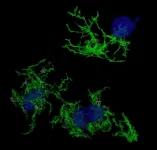Scientists discover gene signature for plaque-eating microglia in Alzheimer's Disease
2021-05-21
(Press-News.org) SINGAPORE, 21 May 2021 - Alzheimer's Disease is the most common form of dementia and is characterised by the build-up of amyloid plaques in the brain. Microglia, the immune sentinels of the brain, are not only responsible for eliminating foreign invaders, but also maintaining brain homeostasis by clearing toxic waste such as the amyloid plaques.
However, the role of microglia in Alzheimer's Disease and its relationship to amyloid plaque accumulation remain unclear. Now, a team of scientists from Duke-NUS Medical School and Monash University have found the gene expression signatures underlying microglia associated with amyloid plaque phagocytosis - i.e. the engulfing of deposits of the amyloid beta (Aβ) protein in the brain. The findings, reported in the journal Nature Communications, offer a new target for interventions that aim to address the underlying disease mechanism of this incurable disease.
To investigate the differences between healthy brains and those of patients with Alzheimer's Disease at the single cell resolution, the team of scientists at Duke-NUS and Monash embarked on an ambitious project to comprehensively study gene expression changes in specific human brain cell types that are associated with progression of Alzheimer's disease. From that study, which was published in Nature Neuroscience in 2019, the team have honed in on microglia.
"We sought to understand the molecular mechanisms and differences between microglia that were actively engulfing amyloid plaques in Alzheimer's disease and those that weren't," said Associate Professor Enrico Petretto from Duke-NUS's Cardiovascular and Metabolic Disorders Programme, a co-senior author of the study.
The team did this by using a stain, called methoxy-XO4, that specifically targets microglia that have engulfed amyloid plaques. They used the stain in preclinical models of Alzheimer's disease and then examined gene expression in the stained microglia. They investigated differences in gene expression underlying microglia's ability to ingest particles (e.g. amyloid plaque) and identified associated regulatory molecules.
"Understanding this mechanism is important because now we have several new targets to go after, and in the future, these targets may open a new front against this devastating disease," said Professor Jose M. Polo from the Monash Biomedicine Discovery Institute, a co-senior author of the study.
The studies revealed that for microglia that have not taken up amyloid, their gene expression patterns are most similar to aged microglia, which are known to be dysfunctional and a major player in Alzheimer's Disease pathogenesis. In addition, after microglia engulfed the amyloid plaques associated with Alzheimer's Disease, they develop a characteristic gene expression pattern or signature. This change in gene expression is induced, in part, by a gene called Hif1a. The changed gene expression increases the ability of microglia to take up proteins such as amyloid, while reducing Hif1a does the reverse, highlighting the importance of Hif1a in controlling this microglia function. This regulatory role of Hif1a might also apply to the microglia function of removing damaged synapses.
"It is possible that this process is initially protective," said Assoc Prof Petretto, "with the microglia effectively pruning damaged synapses located near plaques." The scientists suspect, however, that this pruning process later goes awry as the disease progresses.
The team also used computational models to predict the networks of molecules involved in microglia uptake of proteins and identified potential targets to study for drug development. The widely used immunosuppressant drug rapamycin, for example, was found to block the gene Hif1a from triggering microglia to engulf amyloid plaques.
"This relationship between Hif1a and cognitive decline in Alzheimer's disease is yet to be comprehensively uncovered," said PhD student Gabriel Chew, who is a co-first author of the paper. "Future work could focus on using gene editing tool CRISPR to test the impact of manipulating Hif1a on symptom severity and disease progression."
INFORMATION:
[Attachments] See images for this press release:

ELSE PRESS RELEASES FROM THIS DATE:
2021-05-21
More than 100 kg of highly toxic uranium (U) and plutonium (Pu) was dispersed in the form of tiny 'hot' radioactive particles after the British detonated nine atomic bombs in remote areas of South Australia, including Maralinga.
Scientists say that these radioactive particles persist in soils to this day, more than 60 years after the detonations. Previously, we had limited understanding of how Pu was released from these "hot" particles into the environment for uptake by wildlife around Maralinga.
But now, a new study published today in Scientific Reports and led by Monash University researchers warns that the particles are actually more ...
2021-05-21
A new study shows that the current rate of biodiversity decline in freshwater ecosystems outcompetes that at the end-Cretaceous extinction that killed the dinosaurs: damage now being done in decades to centuries may take millions of years to undo.
The current biodiversity crisis, often called the 6th mass extinction, is one of the critical challenges we face in the 21st century. Numerous species are threatened with extinction, mostly as a direct or indirect consequence of human impact. Habitat destruction, climate change, overexploitation, pollution and invasive species are among the main causes for Earth's biota to decline rapidly.
To investigate the tempo of extinction and predict recovery times, an international team of evolutionary biologists, paleontologists, geologists and modelers ...
2021-05-21
One of the key aspects of academic and industrial research today is non-destructive imaging, a technique in which an object or sample is imaged (using light) without causing any damage to it. Often, such imaging techniques are crucial to ensuring safety and quality of industrial products, subsequently leading to growing demands for high-performance imaging of objects with arbitrary structures and locations.
On one hand, there has been tremendous advancements in the scope of non-destructive imaging regarding the region of electromagnetic (EM) spectrum it can access, which now ranges from visible light to as far as millimeter waves! On the other, imaging devices have become flexible and wearable, enabling stereoscopic (3D) visualization ...
2021-05-21
Because individual atoms or molecules are 100 to 1000 times smaller than the wavelength of visible light, it is notoriously difficult to collect information about their dynamics, especially when they are embedded within larger structures.
In an effort to circumvent this limitation, researchers are engineering metallic nano-antennas that concentrate light into a tiny volume to dramatically enhance any signal coming from the same nanoscale region. Nano-antennas are the backbone of nanoplasmonics, a field that is profoundly impacting biosensing, photochemistry, solar energy harvesting, and photonics.
Now, researchers at EPFL led by Professor Christophe Galland at the School of Basic Sciences ...
2021-05-21
Research has shown that joining a gang is associated with increased criminal behavior. A new study examined whether the intermittent nature of gang membership affects offending. Researchers sought to determine whether the association with increased offending was a consistent attribute or, since people enter and exit and re-enter gangs, whether the intermittent nature of membership affected members' likelihood of offending. The study found that first-time membership was associated with increases in criminal behavior from when gang members were not in gangs, and that joining for a second ...
2021-05-21
The plant Aristolochia microstoma uses a unique trick: its flowers emit a fetid-musty scent that seems to mimic the smell of decomposing insects. Flies from the genus Megaselia (family Phoridae) likely get attracted to this smell while searching for insect corpses to mate over and lay their eggs in. When they enter a flower, they are imprisoned and first pollinate the female organs, before being covered with pollen by the male organs. The flower then releases them unharmed.
"Here we show that the flowers of A. microstoma emit an unusual mix of volatiles that includes alkylpyrazines, which are otherwise rarely produced by flowering plants. Our results suggest that this is the first known case of a flower that tricks pollinators by smelling like dead and rotting insects rather than vertebrate ...
2021-05-21
UK doctors have nothing to fear from the introduction of a central register listing money or benefits they receive in addition to their NHS salary, say experts today ahead of a public meeting on the issue hosted by the All-Party Parliamentary Group for First Do No Harm and The BMJ.
Last year the Independent Medicines and Medical Devices Safety Review, chaired by Baroness Julia Cumberlege, investigated harmful side effects caused by the hormone pregnancy test Primodos, the anti-epileptic drug sodium valproate, and pelvic mesh.
During the review, she heard from patients who were concerned that clinicians ...
2021-05-21
Within the next decade, the novel coronavirus responsible for COVID-19 could become little more than a nuisance, causing no more than common cold-like coughs and sniffles. That possible future is predicted by mathematical models that incorporate lessons learned from the current pandemic on how our body's immunity changes over time. Scientists at the University of Utah carried out the research, now published in the journal Viruses.
"This shows a possible future that has not yet been fully addressed," says Fred Adler, PhD, professor of mathematics and ...
2021-05-21
LA JOLLA, CA--Fast-spreading variants of the COVID-19-causing coronavirus, SARS-CoV-2, carry mutations that enable the virus to escape some of the immune response created naturally or by vaccination. A new study from scientists at Scripps Research, along with collaborators in Germany and the Netherlands, has revealed key details of how these escape mutations work.
The scientists, whose study appears in Science, used structural biology techniques to map at high resolution how important classes of neutralizing antibodies bind to the original pandemic ...
2021-05-20
Environmental quality is associated with advanced-stage prostate cancer at diagnosis, according to a new study by University of Illinois Chicago researchers.
Prostate cancer is up to 57% heritable, with the remainder attributed to environmental exposures. However, studies on those environmental factors and prostate cancer aggressiveness have previously been limited. For their study, "Association between environmental quality and prostate cancer at diagnosis," published in the journal Prostate Cancer and Prostatic Disease, researchers paired data from the environmental quality index, or EQI, and the Surveillance, ...
LAST 30 PRESS RELEASES:
[Press-News.org] Scientists discover gene signature for plaque-eating microglia in Alzheimer's Disease




